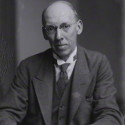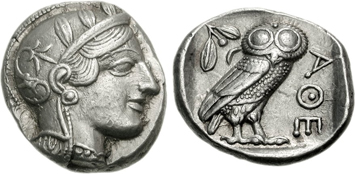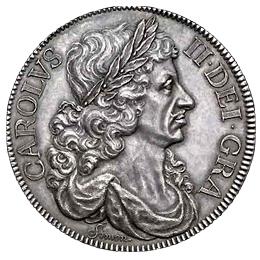A Scion Society of The Baker Street Irregulars

Max Carrados – A Numismatic Detective
Sherlock Holmes, Father Brown, Hercule Poirot and Lord Peter Wimsey are all names that readily spring to mind in the field of detective fiction. Less well known, but no less interesting, is Max Carrados, the blind detective created by Ernest Bramah. Not only was the author an expert numismatist, but his creation Carrados was too, and coins figure prominently in many of his stories.

Ernest Bramah or Ernest Bramah Smith to give him his full name was born in Manchester, England in 1868, and initially tried farming as a career before turning to journalism. His first work of fiction, The Wallet of Kai Lung, was published in 1900 and chronicles the tall tales of Kai-Lung in a rather laboured mock Chinese idiom. Further “Lung” books followed over the next few years. Releasing multiple stories is a great achievement for Ernest Bramah, and even some of the biggest authors in the world at the minute may not accomplish writing more than one novel. What makes it even more extraordinary is that it would have been very unlikely that Bramah had access to “freelance editors near me” at the time, so everything you see and read may have been done from his very own hand. This was just the beginning of his journey though. In 1914, the first Carrados book of stories, called simply Max Carrados, appeared on the London bookstalls, two others followed after the war, The Eyes of Max Carrados in 1923 and Max Carrados Mysteries in 1927.
Carrados, blinded in an accident with a twig, is able to work wonders by his acuteness of sensory perception, ably assisted by his trusty butler Parkinson. To fully appreciate the stories a certain suspension of belief is sometimes required. For instance, in The Coin of Dionysus the first story published in Max Carrados, he is called upon by a private investigator (Carlyle) concerning the authenticity of a rare and valuable Sicilian Tetradrachm, an imminent arrest depends upon its genuineness.
“For a few seconds, Carrados handled the piece with the delicate manipulation of his fingertips, while Carlyle looked on with a self-appreciative grin. Then, with equal gravity, the blind man weighed the coin in the balance of his hand. Finally, he touched it with his tongue.”
“Well?” demanded the other.
“Of course I have not much to go on and if I was more fully in your confidence I might come to another conclusion.”
“Yes, Yes”, interposed Carlyle with amused encouragement.
“Then I should advise you to arrest the parlour-maid Nina Brun, communicate with the police authorities of Padua for particulars of the career of Helene Brunesi and suggest to Lord Seastoke that he should return to London to see what further depreciation has been made to his cabinet.”
 Impressive stuff, and we are treated to similar pieces of staggering perception in most of the other stories. Carrados is a specialist in Greek Tetradrachms and we are told that, as such, he would only have a condescending interest in the non-classical branches of numismatics. His blindness is never used as a gimmick, nor something to be treated as a disability but rather as a legitimate factor of added interest.
Impressive stuff, and we are treated to similar pieces of staggering perception in most of the other stories. Carrados is a specialist in Greek Tetradrachms and we are told that, as such, he would only have a condescending interest in the non-classical branches of numismatics. His blindness is never used as a gimmick, nor something to be treated as a disability but rather as a legitimate factor of added interest.
 Whilst coins are mentioned in a number of the stories, only one is entirely based on a numismatic theme. The Mystery of the Vanished Petition Crown, published in 1927, deals with the theft of the above from a London auction house. Lot 64 in Lang and Lengs Coin Sale is noticed missing when displayed at the tables and a comparatively valueless coin of similar appearance put in its place.
Whilst coins are mentioned in a number of the stories, only one is entirely based on a numismatic theme. The Mystery of the Vanished Petition Crown, published in 1927, deals with the theft of the above from a London auction house. Lot 64 in Lang and Lengs Coin Sale is noticed missing when displayed at the tables and a comparatively valueless coin of similar appearance put in its place.
Carlyle, the detective calls on Carrados, his client being a lady journalist who is suspected of the theft, as the last person to view the coin in conjunction with a newspaper article she is writing. Carrados subsequently interviews her and she relates how only two or three people were at the viewing, with one attendant.
“I believe that I could have picked up the coin and walked out of the place with it.”
At the subsequent sale there are only twelve of fifteen people.
“They sat at tables, I suppose you know how they are arranged, as a sort of hollow oblong with the auctioneer at one end and the attendant showing the coins up and down in the middle and a few sitting here and there about the room. I didn’t sit down, I stood between the table and the door waiting for the price of Lot 64 which was the only thing I wanted. When he got to it, there was a slight stir of interest, though a more lethargic set of enthusiasts I never saw.”
As a description of an auction much has changed, coins are no longer shown during the sale and the internet has dramatically changed the feeling in the room.
It is interesting to speculate on whom the Auction House is based, perhaps the name Lang and Lengs gives us a clue, as Lengs is an anagram of Glens the trade diminutive for Glendinings now absorbed under the Bonhams umbrella.
Returning to the story, it transpires that our lady journalist inadvertently switched the petition crown with an ordinary Charles II Crown in an earlier lot, described as Lot 56 – Charles II Crowns various dated, in fine condition generally, 7″. It seems that whilst marveling that anyone might pay so much for one coin when another one almost identical could be had for a few shillings she confused the two lots!
Carrados is immediately hot on the trail, the purchaser of Lot 56, a Mr. Marrabel, the dilettante collector, apparently saw our heroine accidently switch lots. He hurried home to his Mayfair flat and returned well in time to purchase Lot 56, surreptitiously switching the Petition Crown with the one he had brought with him, when the lot was given to him by the attendant. Rather than risk being searched, he hid the coin in a crevice in a chair, intending to collect it the following day when returning to view a sale of enamels.
Needless to say, he is caught red handed and the auctioneers, not wanting to prosecute a man of their own class, get him to sign a confession, prior to his emigrating to New York.
Thus concludes another successful Carrados investigation. Bramah himself shared with his creation an expert knowledge which he used in writing A Guide to the Varieties and Rarity of English Regal Copper Coins in 1929. The book described the coinage from Charles II to Victoria and was a useful precursor to Pecks English Copper Coins. Spink confidently recommended this handy volume to their readers in the review in their August 1929 circular.
Ernest Bramah was a kindly self-effacing man, described as small and bald with twinkling black eyes, he lived in quiet retirement in Somerset until his death in 1942.
Whilst his stories are not widely read now, he was very highly regarded at the time and many of the stories still appear in contemporary anthologies.
This post was originally published on Simon Monk’s website.
 In 1974, after a brief and inglorious flirtation with the legal profession, Simon Monks joined Coins & Antiquities Ltd, well known Bond Street dealers who specialised in ancient and medieval coins and classical antiquities. There Monks received a superb grounding in all areas of numismatics, which stood him in good stead when he joined Patrick Deane Coins in 1978. Patrick’s company, dealing in top quality English coins, took him all over the world, particularly to the United States. Monks set up his own business in 1985, dealing in all areas of numismatics. Increasingly, he found himself drawn to the para-numismatic or exonumia side of coins and he now specialises in historical medallions, tokens, tickets and passes. His website showcases these items, with an emphasis on how they relate to collecting in it’s broadest sense, showing that they belong to the world of antiques and social history rather than the narrow confines of the coin world.
In 1974, after a brief and inglorious flirtation with the legal profession, Simon Monks joined Coins & Antiquities Ltd, well known Bond Street dealers who specialised in ancient and medieval coins and classical antiquities. There Monks received a superb grounding in all areas of numismatics, which stood him in good stead when he joined Patrick Deane Coins in 1978. Patrick’s company, dealing in top quality English coins, took him all over the world, particularly to the United States. Monks set up his own business in 1985, dealing in all areas of numismatics. Increasingly, he found himself drawn to the para-numismatic or exonumia side of coins and he now specialises in historical medallions, tokens, tickets and passes. His website showcases these items, with an emphasis on how they relate to collecting in it’s broadest sense, showing that they belong to the world of antiques and social history rather than the narrow confines of the coin world.

[…] up on Simon Monk’s post on the numismatic detective Max Carrados, we have a few related links and comments to […]
[…] time to time, we will feature a post here regarding other fictional detectives, such as Max Carrados. Today, we feature Gregory Hood, a San Francisco based antiquities importer and amateur detective. […]